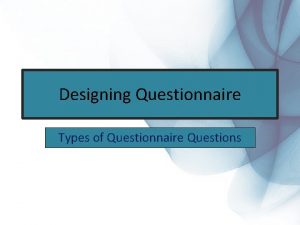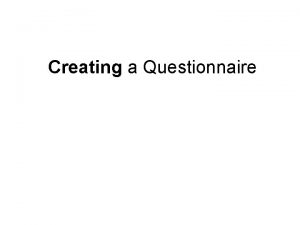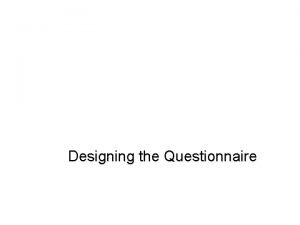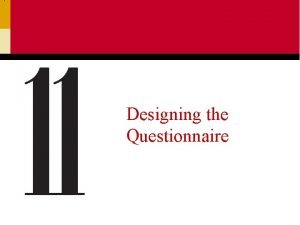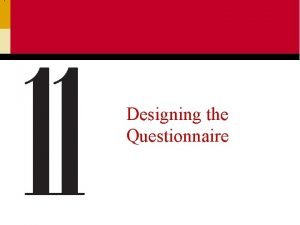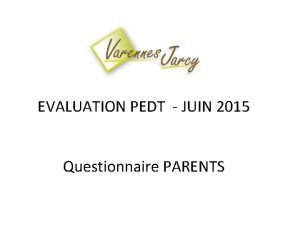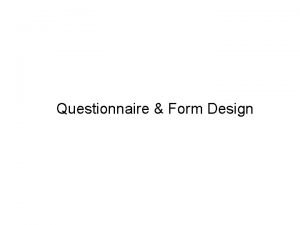Developing Questionnaire What is Questionnaire The questionnaire is











































- Slides: 43


Developing Questionnaire

What is Questionnaire? “The questionnaire is a widely used and useful instrument for collecting survey information, providing structured, often numerical data, being able to be administered without the presence of the researcher, and often being comparatively straight forward to analyze”. (Wilson & Mc. Lean, 1994).

Advantages of Questionnaires �Questionnaire are certainly more objective then other data collection methods. �Information can be collected from large portion of the population. �Relatively quick to collect information.

Disadvantages of Questionnaires �Non availability of Actual Event Data may produce a bias or a false response. �Superficial �Unwilling �Problem response from the responded. with the Open Ended Questions is that too much variable response can cause analysis problems.

Types of Questionnaire There are three types of Questionnaires: �Structured �Semi Questionnaire. Structured Questionnaires. �Un-structured Questionnaire.

Structured Questionnaire �A structured questionnaire is used in large surveys where specific answers are anticipated. They include the use of multiple choice and scale questions. �Structured questionnaires do not allow the person doing one to deviate from the issue being researched.

Semi-structured Questionnaire �Semi-structured questionnaire use both characteristics of a structured and unstructured Questionnaire. �The semi-structured Questionnaires are the best way to go about, contain both open ended and closed ended questions.

Unstructured Questionnaire �Questions are asked with the intention of accumulating a large variety of responses. �Format is flexible and consists of open ended questions hence large amount of data can be obtained. �However large sample sizes can create a nostalgia for performing analysis and drawing conclusion.

Types of Questions There are four Types of Questions. 1. Open Ended Questions. 2. Closed Ended Questions. 3. Mixed Questions. 4. Pictorial Questions.

Open Ended Questions �These Questions consists of few blank lines in front of the question to get a variable desired response. The length of the response must be restricted. �The problem with these questions may arise that the response from the responded may be unclear or vague in terms of perception. � One should avoid putting too much of open ended questions.

Example: Q: What is the one thing in fashion without which you feel that your personality is incomplete? ______________________

Closed Ended Questions �Closed Ended Questions are those questions in which all the possible responses from a respondent are determined and then the respondent is free to choose and answer the question.

Example: Q: How often do you go for shopping? a) Once a week b) Twice a week c) Fort nightly d) Once a month

Mixed Questions have both close and open ended nature in them. Example: Q: Which commercial market do you visit the most to buy your clothes? a)Defence Commercial Market Y Block b) Anaarkali c) Liberty d) Mall Road e) Any other, please specify. __________________

Pictorial Questions �The questions use graphical image to induce a response from the respondent. �Pictorial Questions are rarely used these days in Questionnaire Survey.

Characteristics of Good Questionnaire 1. Validity: A good Questionnaire is valid meaning that every question in the questionnaire is phrased in such a way that it is well understood by all the respondents. 2. Reliability: It means that every questionnaire must yield the same answer if it is posed to the respondent repeatedly in a very short span of time. Any discrepancy must be removed in a “Test –retest”.

Characteristics of Good Questionnaire 3. Interesting: An Interesting Questionnaire is most likely to be completed and gives higher response rate. 4. Succinct: A succinct questionnaire asks question which aim to cover the research objectives.

How can we develop a Questionnaire? The Questionnaire Design and development process can be summarized into three basic steps: 1. Developing Questions of the Questionnaire. 2. Organizing the Questions of a Questionnaire. 3. Administering the Questionnaire.

1. Developing Questions Well Defined Research Objectives Start Developing Questions Using 5 Ws General Considerations

Our Research Objectives For Example: A case study on; How do the latest fashion trends and customer preferences in clothing influence the garment sales in Lahore? In this case study our research objectives will be: �To determine the factors that affect the garment buying trends in the audience. �To determine which type of clothing is most prevalent amongst the audience. �To determine what portion in the audience is turning out to be brand conscious.

Develop Questions using 5 Ws The first question now comes to our minds is where to start from. Then probably the best answer to that will be starting the questions from 5 Ws, such as What, Where, Why, When, Who. This requires a questionnaire designer conduct multiple brainstorming sessions. For Example: �What is the meaning of fashion for you? �Who is your favorite designer? �Where do you usually go for shopping?

General Considerations �Question should focus a single issue or a topic. �Questions should be brief. �Questions must be interpreted the same by all respondents. �Question must use respondent’s core vocabulary.

General Considerations �Question must not use a specific example to represent a general case. �Question should not require a respondent to guess a generalization. �Questions must not use ambiguous wordings. �Questions must not be double barreled.

General Considerations �Questions must not drive the respondent to a particular answer. �Question must avoid using words that tend to drive the respondents emotionally or evolve ethnicity. �Questions must not be out of the respondents experience.

2. Organizing the Questions • These questions are used to identify the respondent types as described by the researcher in the survey. Screening Questions • These question are written in a very simple words and neutral tone with a purpose to generate the interest of the Warm up respondent in the research. Questions • These notify the respondents that the subject or format of the following question will change. Transition Statements

2. Organizing the Questions • Indicates respondent that there are not many questions left for the respondent to fill. Complicated Question Classified and Demographics • Indicate the closure of the questionnaire.

Flow of Questions. There are three approaches to the flow of Questions in Questionnaire. 1. Funnel Approach: This approach focuses questions with general inquiries at the top and questions with the specific inquiries to be asked later on in the Questionnaire.

Flow of Questions. 2. Work Approach: This work approach is employed when the researcher realizes that the respondent would require different mental efforts to answer different Group of Questions. Therefore the difficult set of question are placed deep later in the questionnaire. These are the questions with scaled.

Flow of Questions. 3. Section Approach: As the complexity and mental effort required from the respondent increases it is better to arrange the questions on the basis of their logical reasoning into sections. This divides the concentration of the respondent into different modes (mind set), each mode referring to specific type of Questions.

3. Administering the Questionnaire Pre-coding the Questionnaire �The Pre-coding of the questionnaire means assigning numerical codes to Questions option in order to facilitate data entry. �It seems simple but it may become a tedious task when there are open ended question in the questionnaire. �The codes must distinguish themselves from the options as they might be confusing for the respondent.

3. Administering the Questionnaire Testing of the Questionnaire �Before finally launching the Questionnaire it is imperative for us to validate it, check it for reported errors or discrepancies. This is done through a short run testing of the Questionnaire. �The testing includes selecting a small sample of respondents from the actual population which are true representatives of the population. �The questionnaire is then distributed to all and the feedback, reported discrepancies are noted and immediately addressed.

Developing Questionnaire “A Case Study”

Problem Statement “How do the latest fashion trends and customer preferences in clothing influence the garment sales in Lahore? ”

Research Objectives �To determine the factors that affect the garment buying trends in the audience. �To determine which type of clothing is most prevalent amongst the audience. �To determine what portion in the audience is turning out to be brand conscious.

Target Audience The audience for the case study is group of females taken at random from various parts of Lahore representing the population of Lahore. The females belong to the age Group of 20 -25 irrespective of the fact that they are house wives or working professionals.

Research Methodology � The type of survey used to perform the research will be a Questionnaire Survey. � Questionnaire will comprise of mixed questions i. e. open ended and closes ended making the research both Qualitative and Quantitative. � Selection of sample may be done through Block Sampling after performing Geo-spatial analysis dividing the population into Blocks representing the locality or sector they represent.

Scope of the study �The targeted audience will be distributed questionnaires clearly keeping confidentially. �The questionnaire to be developed is desired to get a true response from the respondent eliminating any chance of biasness. �The response time of the respondent will be minimized by constructing a brief and easy to understand questionnaire.

Scope of the Study �For the research the climatic condition in Lahore is taken to be moderate like spring season.

Analysis of the Survey Since both open ended and close ended questions are a part of the research so both qualitative and quantitative analysis can be performed. Pie Charts can also be developed to show the results graphically. Basic aim for the analysis requires the data from all respondents need to be transferred onto the single or 2 sheets according to the number of respondents and questions.

Pie chart is shown below in which each color segment represents a ratio in % out of 100, Sales 1 st Qtr 2 nd Qtr 3 rd Qtr 4 th Qtr


Questions Please!
 độ dài liên kết
độ dài liên kết Quá trình desamine hóa có thể tạo ra
Quá trình desamine hóa có thể tạo ra Môn thể thao bắt đầu bằng chữ f
Môn thể thao bắt đầu bằng chữ f Hát kết hợp bộ gõ cơ thể
Hát kết hợp bộ gõ cơ thể Khi nào hổ con có thể sống độc lập
Khi nào hổ con có thể sống độc lập điện thế nghỉ
điện thế nghỉ Dot
Dot Thế nào là sự mỏi cơ
Thế nào là sự mỏi cơ Trời xanh đây là của chúng ta thể thơ
Trời xanh đây là của chúng ta thể thơ Voi kéo gỗ như thế nào
Voi kéo gỗ như thế nào Thiếu nhi thế giới liên hoan
Thiếu nhi thế giới liên hoan Fecboak
Fecboak Một số thể thơ truyền thống
Một số thể thơ truyền thống Thế nào là hệ số cao nhất
Thế nào là hệ số cao nhất Lp html
Lp html Hệ hô hấp
Hệ hô hấp Tư thế ngồi viết
Tư thế ngồi viết Số nguyên là gì
Số nguyên là gì đặc điểm cơ thể của người tối cổ
đặc điểm cơ thể của người tối cổ Mật thư anh em như thể tay chân
Mật thư anh em như thể tay chân Các châu lục và đại dương trên thế giới
Các châu lục và đại dương trên thế giới Tư thế worm breton
Tư thế worm breton ưu thế lai là gì
ưu thế lai là gì Thẻ vin
Thẻ vin Bàn tay mà dây bẩn
Bàn tay mà dây bẩn Các châu lục và đại dương trên thế giới
Các châu lục và đại dương trên thế giới Bổ thể
Bổ thể Từ ngữ thể hiện lòng nhân hậu
Từ ngữ thể hiện lòng nhân hậu Tư thế ngồi viết
Tư thế ngồi viết Thế nào là giọng cùng tên?
Thế nào là giọng cùng tên? 101012 bằng
101012 bằng Thể thơ truyền thống
Thể thơ truyền thống Chúa sống lại
Chúa sống lại Khi nào hổ con có thể sống độc lập
Khi nào hổ con có thể sống độc lập đại từ thay thế
đại từ thay thế Diễn thế sinh thái là
Diễn thế sinh thái là Vẽ hình chiếu vuông góc của vật thể sau
Vẽ hình chiếu vuông góc của vật thể sau Công thức tính độ biến thiên đông lượng
Công thức tính độ biến thiên đông lượng Thế nào là mạng điện lắp đặt kiểu nổi
Thế nào là mạng điện lắp đặt kiểu nổi Tỉ lệ cơ thể trẻ em
Tỉ lệ cơ thể trẻ em Lời thề hippocrates
Lời thề hippocrates Vẽ hình chiếu đứng bằng cạnh của vật thể
Vẽ hình chiếu đứng bằng cạnh của vật thể Esrc wellbeing in developing countries
Esrc wellbeing in developing countries Developing and managing products
Developing and managing products












































